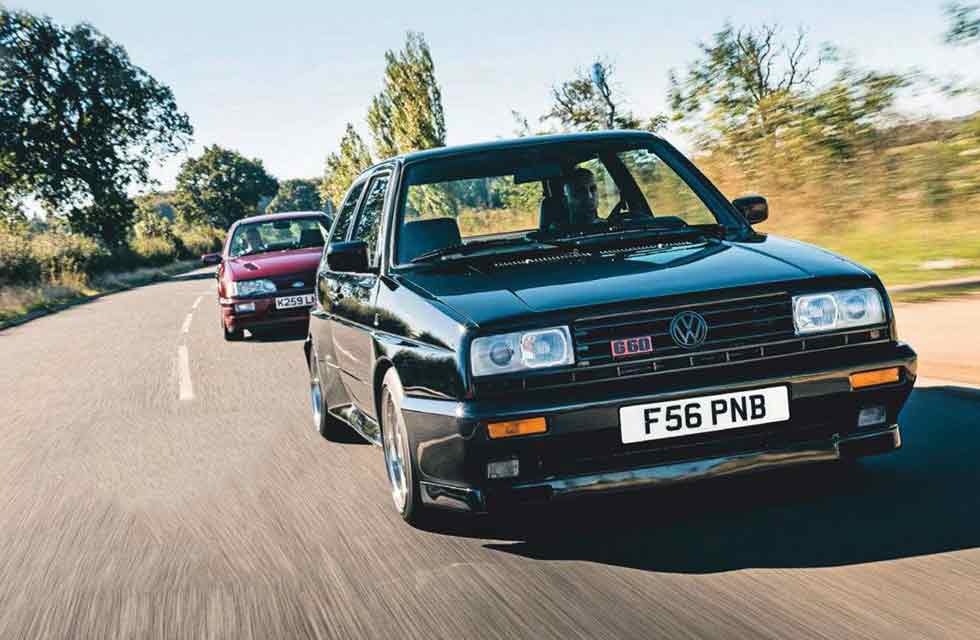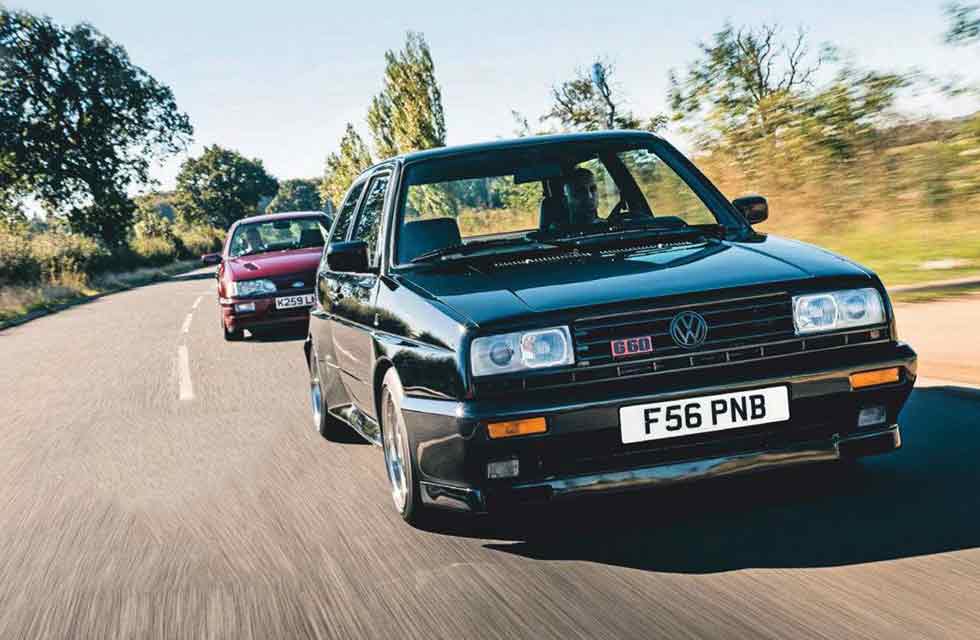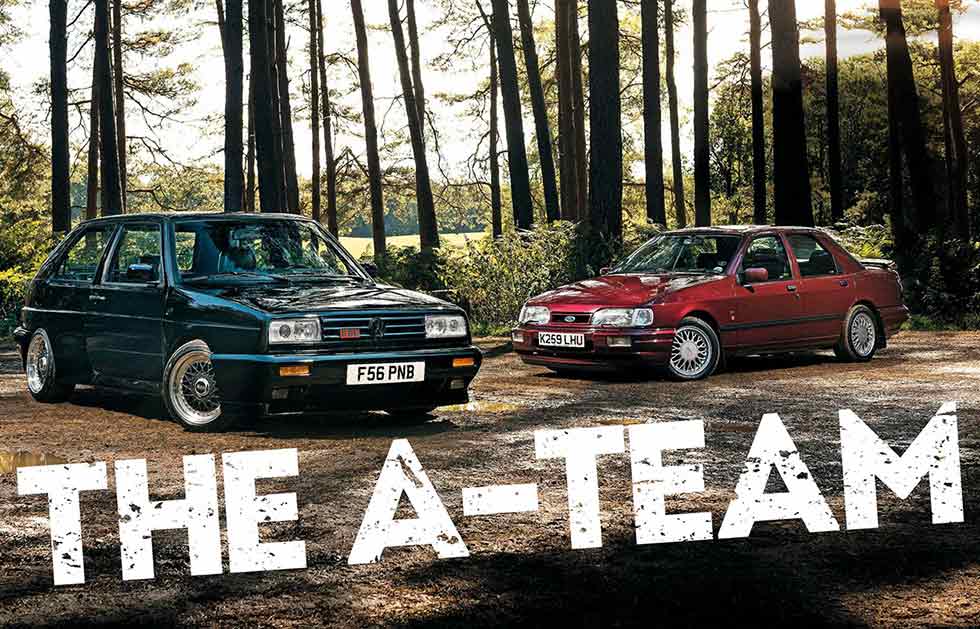
Head to head: group a fighters. The Ford Sierra RS Cosworth 4×4 and VW Golf Rallye offer two takes on rallying for the road. Which is best? The A-Team – the Turbo issue. Inspired by Group A cars that battled with the Delta, Ford’s Sierra RS Cosworth and VW’s Golf Rallye offer a flavour of 1980s rally drama. Words John-Joe Vollans. Photography Jordan Butters.
Cossie vs. Golf Last chance to bag a late-1980’s rally star for sensible cash / Group A for effort: VW Golf Rallye vs Ford Sierra Cosworth 4×4
Glancing at the score sheets from the Group A era you’d be forgiven for thinking it was all about one manufacturer – Lancia. Six successive championship victories (1987-1992) represented the high-water mark for the boys from Turin. This winning streak remains unbeaten to this day, but it wasn’t the whole story… This evocative era saw all manner of marques and models on the podium. Did you know, for example, it was Volkswagen who won the inaugural Group A championship in 1986? Or that Renault campaigned the 11 Turbo to third place in 1987? We thought not. These two cars represent a glimpse into this world.

The daunting realisation that 1987 would be a fresh start for the WRC hit most major manufacturers square in the face. The previous year’s headline-grabbing Group B formula had been canned, meaning the tens of millions of pounds invested in developing cars now rendered obsolete had been wasted. As a result, most development coffers were running low, leading to many makers fielding wholly unsuitable models – such as the leviathan-like Audi 200 Quattro and underdeveloped Subaru Leone – in a vain attempt to put something in front of the TV cameras. Once the 1987 season had begun – now facing real competition – reigning champion Volkswagen realised that its Golf GTI 16V lacked both the required driven axles and the horsepower to mount an effective resistance against the Lancia Delta HF Turbo 4WD. The answer was to morph the Golf into a similarly flared-arched, four-wheel drive rally weapon with forced induction. Wolfsburg broke from the norm with the Golf Rallye by using a supercharger rather than a turbocharger, resurrecting an early-20th century technology that had been abandoned due to reliability and production tolerances. Sadly it proved just as unreliable as it had historically and was gradually dropped in favour of the VR6 from 1992.
’THERE’S A THROATY GROWL FROM THE FORD’S EXHAUST THAT RIGHT AWAY GIVES ME THE PERFORMANCE SOUNDTRACK I WAS HOPING FOR’

Ford, meanwhile, was reeling from the loss of its development work on the RS200 and would also initially struggle to find its Group A stride. The Sierra was the obvious foundation for the firm’s next rally weapon, but which model to choose – the XR4x4 or the three-door circuit legend Cosworth? The former seemed to be a better bet at first and started the ’1987 season. But it soon became clear that the XR4x4, with its heavy Cologne V6, ultimately lacked the power-to-weight ratio to compete at the very highest level. Adapting the three-door Sierra Cosworth late in the season proved more successful.
It wasn’t until the arrival of the Sierra (Sapphire) RS Cosworth in 1989 that Ford Motorsport finally had the answer to Lancia, though. In the hands of Stig Blomqvist and Ari Vatanen, the ‘Saph’ brought the title within reach. Homologation specials always get us excited. They’re the pinnacle of a car’s evolution, often placing driver interaction above all else. They brought new technology from the rally stage to the showrooms, just to save a tenth here and a tenth there. Improved aero, more power and better suspension are just some of the goodies these limited-production motoring unicorns offer. There is a downside of course – their current six-figure price tags. Out of the reach of all but the most well-heeled of petrolheads, for us mere mortals these cars are relegated to the realm of fantasy. Hold on though, don’t despair just yet, there are always exceptions to every rule and these two, sat gleaming in a woodland glade near Woburn, can both be had for a quarter of that cost. That’s right, you can get a slice of late 1980s rally nostalgia for just £25,000 – but this certainly won’t be the case for much longer.
Having a penchant for Volkswagen, I can’t help but be drawn to Satnam Singh’s mischievous-looking black Golf Rallye. The MkII Golf restyle in-house at VW made for a simple and effective update, but many feel it lost some of the original car’s visual flamboyance, something that the Rallye brought back in spades. The first thing that stands out are those square headlights in place of the GTI’s twin spots. Widened arches scream ‘RALLY!’ They make everything look so brutally aggressive. One of the Rallye’s most instantly recognisable visual clues, for the front end they consisted of bolt-on wings that allowed for a widened track and fatter rubber. The Syncro four-wheel drive system, with its viscous coupling, meant all-new sheet metal was needed to widen the rear arches to fit. These bespoke flares start just aft of the doors and don’t extend above the swage line, neatly boxing in each wheelarch. Together with the deep side skirts, revised front and rear bumpers and the square grille, means you can’t mistake the Rallye for just any other GTI.
’THE GOLF RALLYE’S WIDENED ARCHES LOOK BRUTALLY AGGRESSIVE’
Climbing into the cloth buckets, complete with ‘Rallye’ stitching and red pinstripe fabric, I’m left feeling a little let down. The exterior styling is so extrovert that I expected the cabin to reflect it, but it just doesn’t. This example has some extra instruments in the form of optional VDO gauges, plus I’m sat on the ‘wrong’ side of the cabin (all Rallyes were LHD) but other than that it feels just like any other Golf in here. Fiddling about with the immobiliser and stirring the engine into life doesn’t summon any more drama either. The beating heart of this car is essentially a forged version of the GTI’s 1.8-litre, eight-valve engine, fed compressed air by a scroll-type supercharger known as the G-Lader. (OK, we know this is a turbo special issue, but the Rallye is such an interesting aside in the turbo era, it makes for an interesting comparison).
I’m not sure why, but I was expecting the Golf Rallye to be more of a temperamental and stroppy thoroughbred – in fact when you’re driving normally it’s as benign as any GTI. Start to open up the throttle though and this car’s hidden talents start to rise to the surface. The supercharger might not whine like a Roush Mustang’s, but it does provide a constant background buzz and, more importantly, feeds pure torque into the power curve. Though it ‘only’ develops 158bhp, it’s 166lb-ft max torque is achieved at a second-gear-stripping 3800rpm. Together with the phenomenal grip from the Syncro system, this means you’re safe to unleash all of the Rallye’s power more or less any time you want and in any given situation.
’THE SAPPHIRE IS MUCH MORE USEABLE AS A DAY-TO-DAY PERFORMANCE CAR’
The twisty country lanes in this part of Bedfordshire suddenly transform into a Tarmac rally stage as this Golf feels up for max attack at a moment’s notice. Piling into bends at high speed reveals a little tendency for the tail to lighten under trail braking, a tactic that gets the Rallye pointing at the apex earlier than many contemporary four-wheel drive performance cars – especially the Golf’s Group B cousin, the understeer-plagued Ur-quattro.
Switching seats to the Ford’s big, figure-hugging Recaro, it’s clear that I’ve moved into a high-end vehicle. There’s ruched leather all around and although the dashboard is just as full of plastic as the Golf’s, somehow it feels a lot more premium. I’ve got a double-DIN stereo for starters. There’s also that trademark three-spoke leather steering wheel with the ‘RS’ moniker proudly placed in the centre. There’s a lot more kit in the Sapphire: I’ve got four electric windows, a heated front windscreen and padded armrests. It just feels a lot more grown-up.
Turning over the ‘green top’ YB Cosworth engine (that’s right, we’re running on unleaded… fancy) there’s a throaty growl from the exhaust that right away gives me the performance soundtrack I was hoping for. It’s a stainless system and according to owner Sean it’s a set-up that apes the OE pipes. The familiarisation period takes slightly longer than it did with the Golf, even though I’m sat on the ‘correct’ side of the car. There’s a fair amount of body roll which, together with the quick steering, gives this Sierra a slightly wobbly feel. The front end feels quite taut although there seems to be a lot more give at the back. It doesn’t take too long to get adjusted to this, but it’s clear that this Sierra has been set up to worry contemporary BMWs and Opels rather than GTIs.
The MT75 transmission in this Sierra has a solid action, requiring deliberate effort to swap a cog, but combine this with a longer-than-ideal throw to the stick and it can get tiring. The best course of action is to set the Sierra up in the right gear at the right entry speed before entering a corner – the ‘slow in, fast out’ basically. Get the balance of the steering and throttle right and you’re able to exploit the vast grip from its chassis. Attack too early though, and the front end will head for the nearest ditch as the boost takes over proceedings. Get on the gas too late and you’ll be round the bend with a laggy delay before the turbo provides its mighty head of steam.
’TWO CARS WITH RALLY PEDIGREE, FOR LESS THAN THE COST OF A KIA SPORTAGE’
After a few attempts I can start to build a rhythm and then this Cossie comes good. Shifting 1.3 tons about on stock suspension (the Golf is on coilovers) and stock tyres does mean your passengers need a strong stomach if they’re along for a joyride, but this trade-off does make the Sapphire a much more useable day-to-day performance car. The Golf’s rattles and relative lack of soundproofing does get tedious in short order once you’ve eased back on the throttle, while the Sierra couldn’t be more different. There’s a maturity to the Ford’s ride that’s neither overly soft nor spine-shatteringly hard – it’s toward the more comfortable edge of the Goldilocks zone when it comes to ride/handling balance.
Unlike the tail-happy (but hugely fun) rear-wheel drive yobbo Sierras, you don’t need to constantly worry about the rear misbehaving. The patient driving approach might not be as instantly rewarding as the Golf’s scruff-of-the-neck dicing, but it’s ultimately far faster and a much more considered approach to going fast – not something we say about fast Fords too often. Oh and let’s not forget, you can bring the whole family along in the Sierra, something you’d certainly struggle to do in the Golf. Driven hard, the Cossie remains hugely capable and genuinely quick.
The Modern Classics view
Group A bowed out in 1997, and with it a whole host of fabulous machines were relegated to the history books. Yet, 21 years after its demise, you can still go out and buy two of the most engaging driver’s cars ever, with true rally pedigree, for less than the cost of a new Kia Sportage. Hmm… that’s a no-brainer in our book.
The Volkswagen might have never lit up the timing sheets in the WRC – its highest place was a third overall at the 1990 Rally New Zealand – but on our B-roads it’s massive fun, if not ultimately all that fast. The Sierra was far more accomplished in the WRC, scoring a second place at the Tour de Corse in the hands of Francois Delecour in 1992. To be honest, neither got near the Delta or Celica GT-Four, but we’d happily put either of them in our garage.
THANKS To Golf owner Sitnam Singh and the Sierra owner Sean Puckle.
’THE SAPPHIRE IS MUCH MORE USEABLE AS A DAY-TO-DAY PERFORMANCE CAR’
Golf’s tail lightens on the brakes. Straight lines or curves. Your choice. BBS alloys suit the Golf. No BS. Interior’s all a bit subtle and very VW. Just in case you lose your marque. Ford’s ride is a more pliant pleasure. Ford dash has a more premium feel. Sapphire drops the C-bomb. Ruched Recaros. Adults only. The Cossie YBG is pretty reliable. The flawed G-Lader must be serviced. Feels weighty in the corners. This was the order in WRC too. The Rallye is as benign as any Golf GTI. A pair of proper driver’s cars.
I BOUGHT ONE SEAN PUCKLE
‘I love the fact they are like any Ford of the era, making them easy to work on, plus it’s still easy t get most parts for the Sierra. My car is looked after by Dave Pritchard of DP Motorsport – there’s nothing that he doesn’t know about Cosworths. The thing I like most about the Sierra Sapphire Cosworth is its understated looks. To the untrained eye it’s just a Sapphire. You can trundle along in leather-clad comfort taking the kids to school, or give a Ferrari a run for its money.’
I BOUGHT ONE SITNAM SINGH
‘I own many Golf G60s and Rallyes. They’re real forgotten classics – outside VW circles anyway. It’s amazing how well this car has survived, it’s still got all its original metalwork from the factory, there’s no hacked arches here. I’ve modded it a little to suit my tastes, small things like a lightened flywheel, smaller supercharger pulley and a remap. The suspension has been changed for FK coilovers and the exhaust is a bit louder, yet the car’s character remains the same.’
Need to know
FORD RS COSWORTH
It’s an old Ford so of course you’re going to encounter rust. Check the boot well and bootlid plus the rear arches (inside and out). Often overlooked are signs of bubbling under the window and door rubbers. If there’s a sunroof fitted make sure It works and isn’t leaking. Check the headlining for signs of water damage. Tappet noise is common on startup but it should quickly clear. If it persists then you’ll be looking at around £200 to replace the mall. This also indicates a lack of oil changes. It makes sense to fit a new cambelt, tensioner and water-pump while you have the cam out anyway.
The MT75 gearbox in the 4×4 has a weaker third-gear synchro than the usual second, so if it crunches into third, it’s a sign that a rebuild is due.
Golf Rallye 34 UK cars left
WHAT TO PAY
Concours £40,000
Good £25,000
Usable £10,000
Project £8000
VW GOLF RALLYE
The majority of the mechanical components in the Golf Rallye are basically uprated GTI items and prove to be reliable. The G-Lader is another story, as it often fails. Regular servicing at 20,000-mile intervals is considered essential.
Remove the top hose to the supercharger to inspect it for oil. A fine mist is considered normal, heavy deposits mean it hasn’t been serviced in a while and is likely to fail soon. The G-Lader bearings are supplied oil from the engine so it’s crucial that good-quality oil is used and changes are carried out every 6000 miles.
Golfs of this era do resist rust better than many of their peers but they’re far from invulnerable. Sills, petrol filler areas, windscreen bases and sunroof surrounds are all common root spots.
Also check the boot wells tailgate Behind the licence plate) and arches. The ISV or idle stabilization valve Often clogs, causing a hunting idle.
RS Cosworth 216 UK cars left
WHAT TO PAY
Concours £30,000
Good £15,000
Usable £10,000
Project £6000
SPECIFICATIONS VW GOLF RALLYE FORD RS COSWORTH
Engine 1763cc, 4-cyl, SOHC / 1993cc, 4-cyl, DOHC
Transmission 4WD, 5-speed manual / 4WD, 5-speed manual
Power 158bhp @ 5800rpm / 204bhp @ 6250rpm
Torque 166lb-ft @ 3800rpm / 214lb-ft @ 3500rpm
Weight 1195kg / 1302kg
PERFORMANCE
0-60mph 8.6sec / 5.8sec
Top speed 130mph / 143mph
Economy 26mpg / 22mpg





